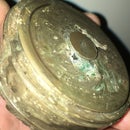Introduction: How to Repair a Cracked Alloy Wheel
With the use and increasing availability of the aluminium alloy series metals, combined with the many alloying agents available today, a plethora of mechanical working properties can be achieved. Most of these developments were primarily discovered for use, in the aerospace industry and have filtered down into everyday applications including cars. It is because the strength vs weight is a very useful characteristic, however certain floors do crop up and these issues can hinder it's many applications.
These are: extreme low temperature when used for heat exchangers, radiators & engine blocks - high temp when used in pressure & combustion applications and centrifugal & torque forces when used for Alloy Wheels - Pulleys rollers and drive-train applications. This instructable is dedicated to: Alloy Wheels on cars.
Alloying agents: There are too many to list, here are some to name but a few; Silicone, Copper, Magnesium, Manganese, & Iron All of these elements enhance certain properties, ranging from increased strength - elasticity (ductility) - improved casting ability - increased heat capacity -& increase tensile strength .please reference wiki for more detailed summary.
------------------------------------Before We Start, here is a Health & Safety Notice----------------------------------------
Disclaimer, even though this repair can be carried out successfully and I have repaired many, there are no guarantees .I would even say in most instances it is safer to just replace the wheel. If however, you are following my instructable, You need to be the judge to what degree repairing an alloy wheel is sensible, safe, economical and advantageous. Why You may ask? ------------------------------------------------------------->>>
Step 1: Judging the Damage, Is It a Logical Repair?
Its simple science .
When an alloy wheel is cast or forged it is then machine finished & surface treated [Polished/ powder-coated-lacquered. The internal structure is stressed but uniform, especially when forged. In the die-casting method precipitation can occur, due to the alloing agents rising to the surface, blow holes, oxide inclusion may also be present, but the wheel is still strong and durable.
When a wheel hits a Pot-Hole or Curb at 30+ MPH the Impact & Shock is absorbed and causes stress fractures or rim distortion [like a dodecagon] ,there is also the 2.2 Bar [31lbs/ FT] Of Tyre pressure squeezing it.........
Being The Judge------------------------------->>>>>>>>>>>>>>Please review the following<<<<<<<<<<<<<<<<
If the wheel has[more than 1 Crack on the inside edge] Throw Away!!!!!! If it has a[Crack with more than 1" travel] Throw Away!!!! If the wheel [Is noticably bent] Throw Away!!!!!! [If Previously Repaired] Throw Away!!!!!
Thats it!, if it is a small enough crack less than 1" and the wheel rolls well then we are in luck :-D!!!!!!!!!!! Proceed To Repair If Your Happy.
Image [1] was previously repaired, Badly - but I laid down this disclaimer very very strongly..........[Image [2] Preparation Necessary [Image 3] Welded & Finished...........
The following steps will guide you through the process involved /// please enjoy ------------------------------------>>>>>
Step 2: Tools Neccessary & Proceedure for Welding Prep.
Large Hacksaw
Oval File
Flat File
Rasp File
Small Round File
Large Round File
80-100 Grit Emery Paper, 320 Grit Emery Paper.
WD40 /Thinners/ Black-Marker Pen
Drill & Drill Bits & Centre Punch
Hammer & Small Flat chisel or Screwdriver
Small Belt Sander [Be Careful/ Unforgiving]
Tig Welder 150 Amps And 1.5/2mm Ally Rod with 5-10 % Magnesium
Hotwash Or Karcher Pressure washer to Clean.
Chain, Or Sling
Nut and Long Bolt.
First Hold Alloy Wheel After Inspection of the Crack & Saw Down One Side Of The Crack [Roughly 1/16th Parallel to it] .Then Using a Screwdriver or flat punch tease it out by tapping it with a hammer......You should end up with a gap & A Piece which resembles [Image 2] & A Gap [Image 3]
Now we need to find the end of the crack which usually stops at the Bead 1" away from the Rims Edge & [Parallel] to it...Drill a hole here with a 13mm drill [Slowly] but not right through, do the same with the underside. Now we make a valley top & Bottom leaving [2mm thickness] Image 4-5 shows this, it also depends on the thickness of the profile. Image [2] shows different wedges I cut out of a job lot. The reason for this is to enable better weldability [Root weld]...
We then have to break the surface Coat with a coarse file and or belt sander [I only use a file and coarse Emery paper] Aluminum Welding Is Fussy & Everything has to be Paint, Grease & Oil Free!!!!!!!!! especially our Crack!
Now We need to pre-heat this, we can do with a hot-wash and then a gentle heat with a big torch [Just To Take the Cold Out So Our Alloy Is Not A Heat Sponge!!!!!!!!
Step 3: Welding With Tig
Once we have a hot alloy, we can start welding [All Valves Need To Be Replaced] & Balance Weights May Fall Off.............Using a long bolt & Nut, Clamp through a wheel hole to create a good ground for our welder.
Start Welding at the inside of the wheel, where we drilled our first hole, Standing by with the filler rod, in A Circular motion create a weld-pool and try to use existing base metal to fuse gap together [Insert Filler Rod When Material Starts To Sink & Bounce Up -------->>>>>>>>>>>>>>>>>> Follow The Gap To The Egde of the Rim filling when necessary to continue the join.----------->>>>>>>>>>
Now Turn Alloy On its side So you can see the full 90/o'S of the gap ------>>>>> The Material from the top [Inside weld] is Visible Between A Shallow Gap......Create a weld pool at the drill hole we made earlier, this should sink and Bounce up, As Before - Its Like Zipping Up A Coat......
Now Two Valley's Have been Made with undercut. We have to Fill them Without Leaving Undercut or Too Much Excess Surface Weld. Like [Image 2-3] Once the existing profile has been rebuilt we can start to reform the radius on the inside edge. [Image 4-5] Leave underside weld As this is not visible and helps reenforce repair.............
This takes time and patience and a keen eye we have to file down the bulk of the weld, continuing the troughs & Valleys of the existing profile, until we get to the critical point where we maintain A Good Continuous Bridge where there was once a crack......... Feeling with your fingers and Looking Along the Joint As You go - We Have a good arsenal of tools to help with this profiling proceedure. When you are close use the Emery Paper To smooth the finish WD40 will give you a shine with the finer paper.
Step 4: Finished & Testing Wheel
Now I perform a visual check for cracks, using black marker and a little drop of thinners or brake cleaner ////// Cover The Weld With Marker then Put a drop of thinners on this and let it disperse --Take a wrag, wet with a little thinners and wipe ---if a crack is visible it will be highlighted in black ink.......
Next Test The Sound Check, Loop A chain or Sash Through One Of the wheel spokes and suspend..........Now take a soft hammer a gently clang like a bell- If cracked a dull ring will SOUND!!!!! If Okay a constant ring will sound until it finally diminishes into the distance 30/40 secs............
Final test putting a valve and tire on [Bead Seal Optional] And Pressurize leave for a few hours -check pressure.......If Okay you can now get Re-Laquered Or Powder-Coated..............
You Now Have Successfully Repaired An Alloy Wheel [Disclaimer Still Applies’ PLEASE READ ALL WRITTEN IN BOLD]
Please Rate & Comment :-D













